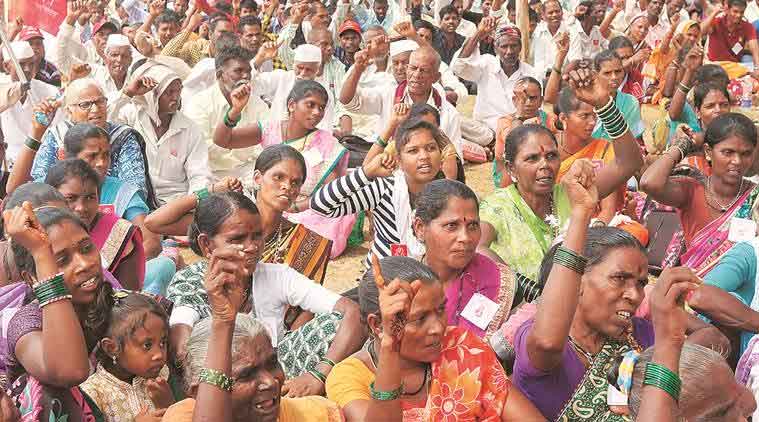 Tribal farmers at Azad Maidan. (Photo: Ganesh Shirsekar/representational)
Tribal farmers at Azad Maidan. (Photo: Ganesh Shirsekar/representational)
MORE THAN 62 per cent of claims filed by tribals for individual land titles in Maharashtra under the Forest Rights Act have been rejected, according to data compiled till March 31, 2018, by the state’s Tribal Development department and accessed by The Indian Express.
Records show that of the 3,59,745 claims for Individual Forest Rights (IFR) submitted under the law that came into force in 2006, 2,24,874 claims, or 62.5 per cent, were rejected in a three-tier process involving local bodies.
These include 51,348 claims rejected by Gram Sabhas, 1,70,126 by Sub-Divisional Level Committees (SDLCs) and 3,390 by District Level Committees (DLCs). Of the appeals filed by IFR claimants, only 41.37 per cent were accepted by DLCs, including claimants rejected previously and those who sought amendments in acreage granted.
Records show the government processed 3,35,660, or 93 per cent, of the IFR claims it received. Of the 1,10,786 claims accepted, land titles have been distributed to 1,10,589 claimants covering 2,60,271.52 acres.
Implementation of the Scheduled Tribes and Other Traditional Forest Dwellers (Recognition of Forest Rights) Act was the central demand of the nearly 40,000 adivasi protestors who undertook a “long march” of 180 km from Nashik to Mumbai in March. Their agitation ended with Chief Minister Devendra Fadnavis assuring that his government would resolve their grievances regarding pending claims and appeals within six months.
This is what records accessed by The Indian Express show:
* In Nandurbar district, where tribals comprise nearly 70 per cent of the population, 39,615 claims were received and all were approved by Gram Sabhas. But as many as 30,931 of these claims, or 78 per cent, were rejected by SDLCs. The remaining were accepted by SDLCs and then by the DLC.
* In Gadchiroli, with a nearly 40 per cent tribal population, 15,924 of the 59,609 claims received were rejected by Gram Sabhas and 23,244 by SDLCs. A further 13 were turned down by the DLC, taking the number of rejected claims to 39,181, or 65.7 per cent.
* In Nashik, of the 50,443 claims received, 674 claims were rejected by Gram Sabhas, 31,534 by SDLCs and 684 by the DLC — a rejection rate of 65.2 per cent.
* Palghar district recorded 60,151 claims, the maximum among all districts, which is seen as an acknowledgement of the decades-long tribal movement for land rights in this region. But it also recorded a rejection rate of 50.99 per cent. Gram Sabhas rejected 19,711 claims and SDLCs 10,966 while the DLC had not rejected any till March 31. Activists said the figures could be misleading, as the SDLCs took up nearly 18,000 Gram Sabha rejections from the Jawhar area in Palghar as suo motu appeals around 2011-12, and accepted most of these claims.

“If you further segregate the data on rejections, you may find there is also more common rejection of claims by the OTFDs (Other Traditional Forest Dwellers), owing to widespread misinterpretation of the provision that three generations of an OTFD claimant’s family should be dependent on forest land. The law is clear that they should be dependent on the land, not necessarily living in one place for three generations,” Dr Geetanjoy Sahu, assistant professor, Tata Institute of Social Sciences, said.
According to Sahu, rejection of claims on technical grounds is common but not in keeping with the spirit of the FRA. “Gram Sabhas are supposed to have cadastral maps (denoting land ownership), but they end up having to chase revenue officials for physical verification of cultivated land because even the forest guards usually don’t have these maps. SDLCs and DLCs should ensure that all Gram Sabhas are equipped with these maps,” Sahu said.
According to officials, the Tribal Development Department is currently implementing a ‘Van Mitra’ (friends of the forest) programme to train officials on the law.
Officials at the Tribal Research and Training Institute, where the module is underway, said the biggest hurdle is lack of training for officials on the law and its spirit. The common belief is that tribal claimants are encroachers and that their claims are akin to diversion of forest land, they said.
Overall, most rejections have come from SDLCs, the second level of processing claims after Gram Sabhas. “That was largely because the SDLC members themselves were never trained on the law. They rejected thousands of claims on grounds that there was no satellite map showing cultivation attached to the claim, or that there was no evidence of a court-imposed penalty for cultivating forest land,” Pratibha Shinde, of the Lok Sangharsha Morcha in Nandurbar, said.
In Nandurbar’s remote and hilly areas, Gram Sabhas managed to form Forest Rights Committees as required by the law but were hampered by the process of getting forest officials to conduct joint mapping exercises. “Even the process of filing appeals against the DLC’s decision remains slow, many families still haven’t procured the additional proof required,” Shinde said.
The resolution of the appeals remains slow, too. Maharashtra’s SDLCs and DLCs received 35,078 and 1,07,315 appeals against their previous decisions. As of March 31, the DLCs accepted 44,399 appeals. But records show a backlog of 10,115 and 25,342 appeals with the SDLCs and the DLCs, respectively.